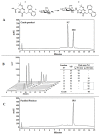Synthetic Peptide Purification via Solid-Phase Extraction with Gradient Elution: A Simple, Economical, Fast, and Efficient Methodology
- PMID: 30925720
- PMCID: PMC6479624
- DOI: 10.3390/molecules24071215
Synthetic Peptide Purification via Solid-Phase Extraction with Gradient Elution: A Simple, Economical, Fast, and Efficient Methodology
Abstract
A methodology was implemented for purifying peptides in one chromatographic run via solid-phase extraction (SPE), reverse phase mode (RP), and gradient elution, obtaining high-purity products with good yields. Crude peptides were analyzed by reverse phase high performance liquid chromatography and a new mathematical model based on its retention time was developed in order to predict the percentage of organic modifier in which the peptide will elute in RP-SPE. This information was used for designing the elution program of each molecule. It was possible to purify peptides with different physicochemical properties, showing that this method is versatile and requires low solvent consumption, making it the least polluting one. Reverse phase-SPE can easily be routinely implemented. It is an alternative to enrich and purified synthetic or natural molecules.
Keywords: gradient elution; peptide; preparative purification; solid phase extraction (SPE); solid phase peptide synthesis.
Conflict of interest statement
The authors declare no conflict of interest.
Figures



References
-
- Ratnaparkhi M.P., Pandya C.S.P. Peptides and proteins in pharmaceuticals. Int. J. Curr. Pharm. Res. 2011;3:1–9.
-
- Schagen S.K. Topical peptide treatments with effective results. Cosmetics. 2017;4:16. doi: 10.3390/cosmetics4020016. - DOI
-
- Sánchez A., Vázquez A. Bioactive peptides: A review. Food Qual. Saf. 2017;1:29–46. doi: 10.1093/fqsafe/fyx006. - DOI
MeSH terms
Substances
LinkOut - more resources
Full Text Sources
Other Literature Sources

